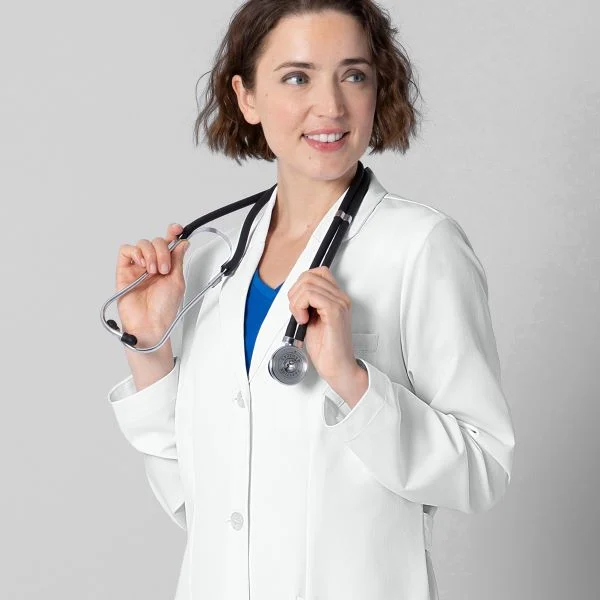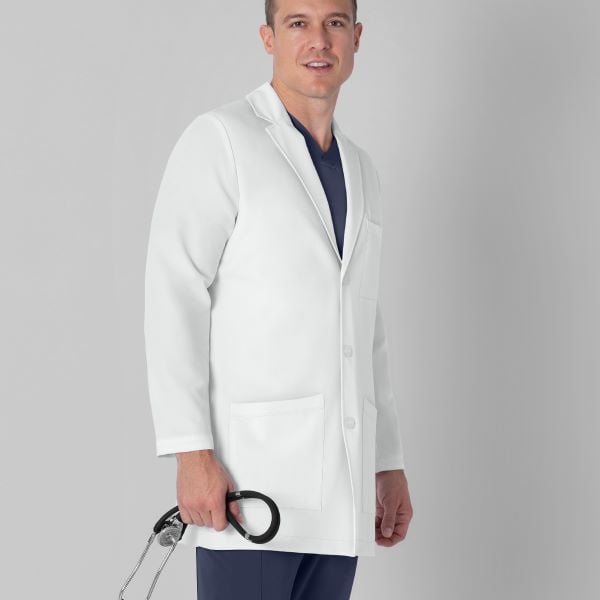Significado y expectativas de la ceremonia de la bata blanca
December 10, 2024
By: Cherice Cooper
In healthcare, the white coat is more than just a uniform; it is a symbol of trust, professionalism, and compassion. For patients, it represents the presence of someone dedicated to their well-being. For students, wearing the white coat is a tangible reminder of their commitment to the demands of their profession and its ethical standards.
During a white coat ceremony, these values and commitments are recognized, and students can mark the start of a fulfilling professional journey.

What is a White Coat Ceremony?
A white coat ceremony is a ceremonial event in which students entering the healthcare profession receive their first white coat. Typically hosted at the beginning of a student’s clinical education, this ceremony sets the tone for their future in the healthcare field.
Although white coat ceremonies are usually associated with medical students, they now often take place across many different healthcare fields, including medicine, nursing, pharmacy, veterinary, and physician assistant training programs. While the specific traditions may vary by institution, the core purpose remains the same: welcoming students into the profession and emphasizing their responsibility to uphold its values.
What is the Meaning of the White Coat Ceremony?
This ceremony marks the transition from classroom learning to clinical practice. It serves as a formal acknowledgment of the student’s readiness to take on patient care responsibilities. With the white coat comes an oath - often based on the Hippocratic Oath or a similar pledge - reinforcing the ethical principles that guide healthcare professionals.
Ultimately, the white coat ceremony meaning is representative of the beginning of a career journey that will change the lives of both the students and their future patients.
What is the History of the White Coat Ceremony?
The white coat ceremony originated in 1993 at the Columbia University College of Physicians and Surgeons. It was established to create a more meaningful transition into the clinical aspects of medical education. Since then, it has been adopted by schools worldwide to honor students as they begin their journey into healthcare.
Expectations for the Ceremony
During the ceremony, you can usually expect to hear speeches from faculty members, alumni, or industry leaders who inspire the students about the road ahead. Students are then called individually to the stage to receive their white coats. This is often followed by a recitation of an oath, symbolizing their commitment to ethical and compassionate care.
Faculty members guide the ceremony and often present the coats to students, while students are celebrated for their hard work and dedication. Families and loved ones are invited to attend, making the event a meaningful moment to share with those who have supported the journey.
How Long Does a White Coat Ceremony Last?
On average, a white coat ceremony lasts between 60 to 90 minutes. The exact time will depend on the size of the class, the number of speeches, and the institution's specific traditions. Smaller programs may have shorter ceremonies, while larger schools might take more time to accommodate a greater number of students.
Preparing for the White Coat Ceremony
If you have a white coat ceremony coming up - whether you're a student or a guest - congratulations! It is an exciting milestone to celebrate, but you may have questions about what you need to do to prepare. Here's what you should know as you get ready for the ceremony:
- What do you wear to a white coat ceremony? Students are usually advised to wear professional attire under their white coats. This could include dress shirts, slacks, skirts, or dresses that are formal enough to honor the significance of the occasion. Attendees like family and friends should also opt for semi-formal or business casual attire to align with the ceremony’s tone.
- Do you bring a gift to a white coat ceremony? It’s common for students to receive small gifts to commemorate the event. Items like personalized stethoscopes, engraved pens, or journals are thoughtful and practical tokens. Some schools may also provide additional keepsakes, such as a commemorative pin or certificate.
- Are there rehearsals for a white coat ceremony? Yes, rehearsals are often held to familiarize students with the event's structure and ensure everything runs smoothly. Students may also be asked to reflect on their journey so far, preparing themselves mentally and emotionally for the responsibilities symbolized by the white coat.

The Cultural and Personal Significance of a White Coat Ceremony
The white coat ceremony is a professional milestone, but it is also deeply personal. For many students, it represents the culmination of years of hard work and sacrifice. It reinforces the values of compassion, empathy, and integrity that are central to healthcare. Students often leave the ceremony with a renewed sense of purpose, ready to embrace the challenges of their chosen field.
Beyond the individual, the ceremony also fosters a sense of community and belonging. By standing alongside peers and mentors, students can feel connected to a larger network of healthcare professionals who share their dedication to improving lives. This collective experience can be a source of inspiration, reminding students that they are part of a respected tradition and a team working toward a common goal.
Additionally, the ceremony offers a unique opportunity for students to reflect on their future roles. It often marks the first time they are publicly recognized as future professionals, solidifying their identity within the field. This moment of recognition can profoundly shape how they approach their careers, instilling confidence and a deeper commitment to the values they will uphold throughout their journey.
After the Ceremony: What’s Next?
The white coat ceremony is only the beginning of a student’s transition into clinical education, marking the shift from theoretical learning in the classroom to hands-on practice. After the event, students will embark on a journey that introduces them to the multifaceted realities of working in healthcare.
Once you complete the ceremony, your next steps will typically include:
- Clinical Rotations and Shadowing: One of the first steps is participating in clinical rotations, where students shadow experienced professionals in various specialties such as internal medicine, pediatrics, surgery, or obstetrics.
- Patient Interaction: Students will begin interacting directly with patients, often for the first time. This includes conducting patient interviews, taking medical histories, and performing basic examinations under the supervision of seasoned practitioners.
- Skills Labs and Simulation Training: At this stage, many programs incorporate skills labs and simulation training into the curriculum. In these controlled environments, students practice essential clinical skills such as suturing, administering injections, and using diagnostic equipment.
- Evaluations and Feedback: Throughout this phase, students receive regular evaluations and constructive feedback from their instructors and mentors, identifying areas of strength and addressing areas for improvement.
- Preparing for Licensing Exams: As clinical education progresses, students often begin preparing for licensing exams such as the USMLE for medical students or the NCLEX for nursing students.
- Building Professional Identity: Students learn to embody the values of their chosen field, navigate ethical dilemmas, and contribute to a collaborative healthcare team. They also start to refine their career goals, identifying areas of specialization or interest that they may pursue further.
This stage is exciting and demanding, requiring adaptability, a commitment to lifelong learning, and navigating complex clinical environments. For many, it is the first real taste of what it means to be a healthcare provider.

Moving Forward into Your Future as a Healthcare Professional
As you step into this new chapter, Uniform Advantage is here to support you. From professional scrubs to lab coats and accessories, we offer everything you need to build a functional and stylish workwear wardrobe.
Shop our selection today to prepare for the exciting road ahead!
